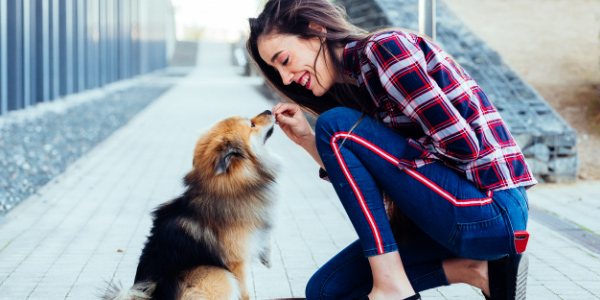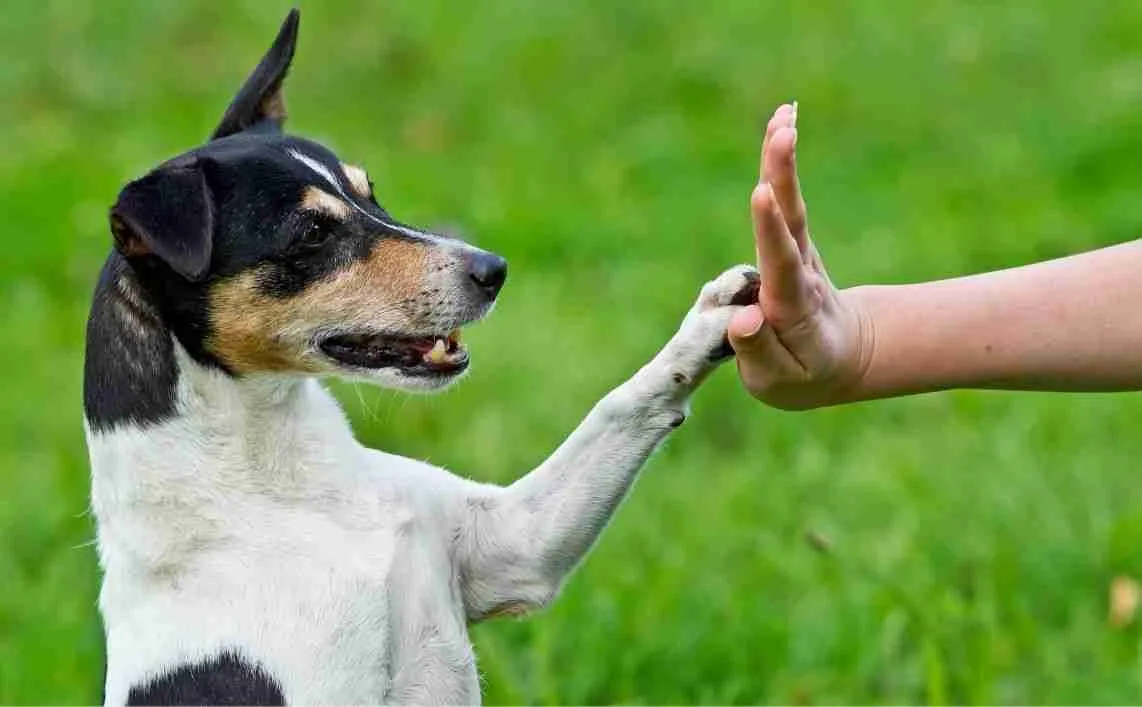Are you struggling with training your Labrador puppy? Are you clueless about how to motivate them effectively? You’re in luck!
This comprehensive guide will discuss the use of treats during training and how to make sure it’s effective. So, let’s dive into how treats can be used to train your furry companion!
Labradors are a favorite breed of dog for many people seeking the perfect family companion. It can be an especially rewarding experience to raise and train your Labrador pup right. A great way to make sure both you and your Labrador have a positive training experience is to incorporate treats into your training program. Many owners find that rewards-based training, in which treats act as positive reinforcement, can be effective when accomplished with patience and consistency. Training behaviors should always be valuable to your pet in order to keep their attention and foster a successful learning relationship between you and your pup.
This guide will explain the use of treats in a rewards-based system, the advantages of such a system, the types of treats available, how long you should use rewards for each behavior and how often you will need to provide them. This guide will also suggest some methods you could use to avoid overfeeding or creating bad habits with food as well as potential alternatives if needed. By learning about traditional reward-based systems, owners can make well informed decisions on how they choose to train their beloved Labradors at home.
Using Treats Effectively
Using treats as a reward for desired behaviors can be an effective way of training your Labrador. Providing treats as reinforcement for desirable behaviors will help to establish the desired behavior and create positive associations. This can improve interaction with you and family members, prevent problem behaviors, and protect property from harm.
Before beginning, it is important to choose the right treats that are easy to break into smaller pieces, easy to transport and store, and appealing enough for your dog to want more. Treats should be about the size of a pea five or six times per day – no joke! Any more than that may cause your Labrador retriever to become overweight, so avoid overfeeding them with treats as a substitute for their regular meals.
When using rewards in training it should always be delivered close after the desired behavior takes place. A split-second delay between the reward and the good behavior results in fewer positive responses from your Labrador retriever. Use high-value treats when teaching something new or when having difficulty getting them to respond. It is important that you only provide rewards once they have successfully completed the task you have asked of them; this will help reinforce this behavior in the future.
You should also pay attention to their posture while they are eating a treat; if their body language indicates fear or aggression towards other people or animals around you then take away the treat until they become comfortable again. Lastly make sure not to give them too many treats at one time– controlling how many rewards you hand out at any moment will keep your Labrador motivated during training sessions.
Timing
Timing is a critical factor in determining how effective treats are at reinforcing good behaviors. Treats should be given while the desired behavior is being performed, otherwise the treat loses its power to motivate. This means providing the treat at the same moment that your Labrador performs a command, or sits on cue. For puppies, this could mean as soon as their back end hits the ground or floor.
The act of giving the treat and verbal praise must be done quickly – almost simultaneously for it to have a positive impact and reward your Labrador for having responded correctly. When the timing is off and you delay the reward by even a few seconds, your dog may have moved onto another behavior and no longer be engaging with you, thus reducing the effectiveness of using treats as a form of reinforcement.
Frequency
Begin training with treats immediately. Training with treats should take place often and regularly — at least two to three times a day — and should be used to reward positive behaviors. It helps when you use consistent language, such as phrases like “Good boy/girl” or “Great job!” Depending on your Lab’s particular temperamental needs and your own schedule, each of these sessions can last anywhere from fifteen minutes to an hour.
Keep rewards consistent. Give your Lab the same type of treat every time — dogs learn best through repetition and consistency, so don’t vary the reward too much as it will confuse your pup. If you can, reward them for good behavior about ten to fifteen seconds after the behavior has occurred—this helps reinforce good habits in a timely fashion. If you prioritize consistency, repetition, and timeliness in your use of treats during training sessions, you will be well on your way to having a happy and obedient pet!
Consistency
Consistency matters when it comes to training your Labrador. Treats should be given reliably, so that your Lab understands there is an overall pattern of reward for behavior. If you give treats intermittently, it can cause confusion and can lead to challenging behaviors in the long run.
For example, if you reward your Lab for sitting after five seconds sometimes and after ten seconds other times, your lab may not understand when a treat is going to occur and may become frustrated. This can lead to misbehavior or aggression which you don’t want.
Therefore, always make sure that you are consistent with rewards for good behavior. Positive reinforcement will help ensure that your Labrador knows when they have done something right! Keeping intermittent treats to a minimum will also help keep them honest- if wanting engagement and rewards is not guaranteed they are more likely to feel motivated by the reward itself leading them to remain focused on the trick rather than feeling like they have just been asked to do something without any hope of a reward at all.
Gradual Reduction
Gradual reduction is a technique that encourages your Labrador to work for rewards with decreasing frequency over time. To begin, offer treats after successful performance of each desired behavior that you are reinforcing. As your dog learns the behaviors, slowly decrease the number of treats given per performance. Eventually, you will no longer need to provide food rewards for the behaviors that have been learned. This encourages voluntary participation and takes advantage of your pet’s natural motivation to perform the desired behaviors for verbal praise or extra pets from you.
Another technique that works well is to reduce treat portions but keep frequency constant until your dog continues to perform without reward at all. Remember, Labrador retrievers are food-motivated and enjoy treats, so reducing this type of reinforcement should be done gradually.
III. Training Tips for Specific Behaviors
When it comes to training Labradors, consistency is key. Knowing what specific behaviors you want your pup to learn and maintaining a consistent response or reward, will help your puppy understand the desired behavior. Here are some tips to keep in mind as you are teaching your Labrador pup new behaviors:
Reward immediately – Make sure there is no time lag between the delivery of the food and the behavior you want your puppy to learn. If there is too much time in between, your puppy will be confused as to why they are rewarded.
Be aware of portion size – Give rewards that are small and easy for puppies to eat but still packed with flavor. Smaller pieces mean it’s quicker for them to eat and digest food rewards so they can stay focused on learning instead of trying to figure out how best to consume the treat.
Use a variety of treats – When possible, use different treats for different commands so that your puppy knows what each command means and which treat he can expect when he follows through with it correctly. Octopus jerky strips make terrific treats because they are easy to break into small pieces and provide plenty of flavor with minimal mess!
Transition training – Transitioning from food reward may take some time from both you and your pup, but building this habit will help him retain his commands more reliably when external rewards diminish over time.
Sit and Stay
Teaching your Labrador the ‘Sit and Stay’ command is an important part of obedience training. This command helps to establish a healthy hierarchy in the home and offers you an opportunity to train your Lab in positive reinforcement.
Begin by introducing the “sit” command with a motivator, like a treat. Every time your Lab responds to your commands, reward him or her with a treat and verbal praise. As they master this command, you can begin using fewer treats while still offering verbal praise and occasional rewards.
Setting up distractions, like other people or animals in the room, will help to reinforce their understanding of what you are asking them to do. Once they demonstrate consistent understanding, you can slowly decrease the frequency of treats until eventually they receive no tangible reward at all.
Come When Called
This is an important step in training your Labrador, as it’s a way of ensuring that you can safely have your dog off-leash and still be able to recall him at any time. It’s important to establish a consistent behavior each time your Labrador obeys the “come” command, so that he learns what behavior is expected of him.
The basic principle is this: call your Labrador, give him a treat when he comes, and praise lavishly when he does so. Make sure the treat is something strongly desired by the dog; cheese and liver treats are especially effective for this purpose. If done correctly, your Labrador should increasingly associate coming when called with positive reinforcement from you in the form of food and praise.
It is important to ensure that you maintain control at all times during this process. Do not allow him to come if it looks like he may ignore or disobey commands or cause any harm while doing so. Always reward immediately upon correct behavior; delayed rewards make it difficult for your Labrador to learn what action earned them the treat.
To encourage even stronger recall, play games with your Lab focused on Come When Called – such as having family members take turns calling him away from his current activity to receive his reward – or team up with other Lab owners you know in order to increase distractions while practicing Come When Called command work. Through repetition and consistency, you will create an obedient relationship between yourself and your cute canine companion!
Leash Training
Leash training gives you a way to safely control your Labrador retriever in public. It is important to start leash training early, as soon as your puppy arrives home. Choose a comfortable and adjustable collar for your dog and ensure it fits properly, so that there is no rubbing or restriction on their neck.
To encourage positive behavior while leash training, use treats. As the dog follows your commands, give them a reward such as treats, toys or verbal praise. Be sure to remain consistent with the reward system, focusing on positive reinforcement rather than harsh punishment when they behave badly while on the leash.
When walking your Labrador on a leash make sure they are always by your side and not walking ahead of you as this will ensure that they understand that you are in charge of the walks. If they do pull ahead simply stop moving until they fall back into position with you before continuing the walk again. By consistently rewarding them for good behaviors when out for walks will slowly but surely teach them how to behave appropriately on a leash in public areas.
Crate Training
Crate training is a safe, effective way to teach your Labrador good behavior from a young age. The crate can be used as a cool, comfortable place for rest and quiet time as well as an effective tool for housetraining your pup. To use the crate effectively:
-Introduce the crate slowly. Start by encouraging your pup to enter the crate with treats or toys. You can also feed your pup their meals inside of the crate to become accustomed to it. Let them move in and out during this period of adjustment until they become comfortable in their “den”;
-When it’s time for housetraining, begin by putting your pup in the crate until they learn that it needs to stay inside when nature calls;
-Be sure not to leave them in there too long, as they need frequent outside breaks;
-When outings are necessary and you are away, utilize the crate whenever possible;
-Once your Labrador puppy learns that the rule is to stay in the crate when you are away from home, they will often choose it when given the chance!
Socialization
Socialization is the process of exposing and acclimating a puppy to new sights, smells, and sounds. Socialization teaches your pup how to behave in a variety of situations while around people and other animals. Socialization also helps to reinforce positive behavior and manage anxiety. Socializing your Labrador Retriever should begin at 8 weeks old but can continue at any age.
To socialize your pup, start by exposing them to new sights, smells, experiences and sounds like taking your puppy for a walk or going for car rides. Taking your pup to pet stores or dog friendly areas can also help with their socialization. Allow other people who interact with your “friend” – such as friends, family or neighbors – the chance to give treats from your hand or pockets when they approach and interact gently with your pup. This way you are teaching them how to behave without being demanding – plus it’s fun for everyone! It also allows other individuals to start building a relationship with your Lab which will increase trust levels across the board.
If any negative behaviors occur when meeting new people or other pets, speak in an assertive tone while praising good behavior aloud and offering sharp corrections verbally if need be; the same instructions should be applied when introducing pets together (if you have more than one pet). Lastly, introduce toys that require movement such as balls in order to provide control of impulse aggression behaviors like nipping or barking too much; toys help pups become more aware of their bodies’ movements which aids in trust building activities between humans as well as dogs.
Conclusion
The use of positive reinforcement with treats for your Labrador is a great way to teach basic and more advanced commands, and can be tailored towards the needs and preferences of your pup.
It’s important to always end on a positive note and give them time to process what they’ve learned before asking them to continue or switch commands. Avoid providing food rewards when they’re not doing as expected; else they may begin to expect a reward, leading to frustration when none is given.
Lastly, make sure that you don’t overdo it with treats, as too many can lead to health complications like obesity. By sticking to the tips we’ve outlined in this guide, you can be sure that your Labrador remains healthy and learns the skills necessary for a positive, happy relationship between pup and owner.
FAQ’s
Is it OK to train your dog with treats?
Yes, training dogs with treats is a commonly used and effective positive reinforcement technique.
What are the best training treats for labs?
The best training treats for labs are small, soft, and low in calories. Good options include boiled chicken, cheese, and commercial training treats made with high-quality ingredients.
Should I train my dog with treats or praise?
Both treats and praise can be effective training tools. However, treats can be especially helpful for reinforcing desired behaviors in the early stages of training.
How long should I train my dog with treats?
The length of time that you should train your dog with treats will depend on your dog’s progress and individual needs. Some dogs may respond well to shorter, more frequent training sessions with treats, while others may require longer sessions over several weeks.
What do professional dog trainers use for treats?
Professional dog trainers often use high-quality, nutritious treats such as boiled chicken, cheese, or commercial training treats made with natural ingredients.
Should I give my dog treats all day?
No, giving your dog treats all day can lead to obesity and other health problems. It’s important to use treats in moderation and as part of a balanced diet.
How many treats should a dog have a day while training?
The number of treats a dog should have while training will depend on the dog’s size, activity level, and individual needs. As a general rule, treats should make up no more than 10% of a dog’s daily caloric intake.
How many treats should a dog have a day during training?
The number of treats a dog should have during training will depend on the length and intensity of the training session. As a general guideline, one or two treats per training session may be sufficient.
How many training treats per day?
The number of training treats a dog should have per day will depend on the dog’s size, activity level, and individual needs. As a general guideline, treats should make up no more than 10% of a dog’s daily caloric intake.
When should I start training with treats?
You can start training your dog with treats as soon as you bring them home. Treats can be used to reinforce positive behaviors and encourage good habits from the start.
See Also-
- Best brush for Labrador
- Best collar for pulling Labrador
- Best crate for labrador puppy
- Best dog bed for Labrador
- Best dog food for labrador retriever


